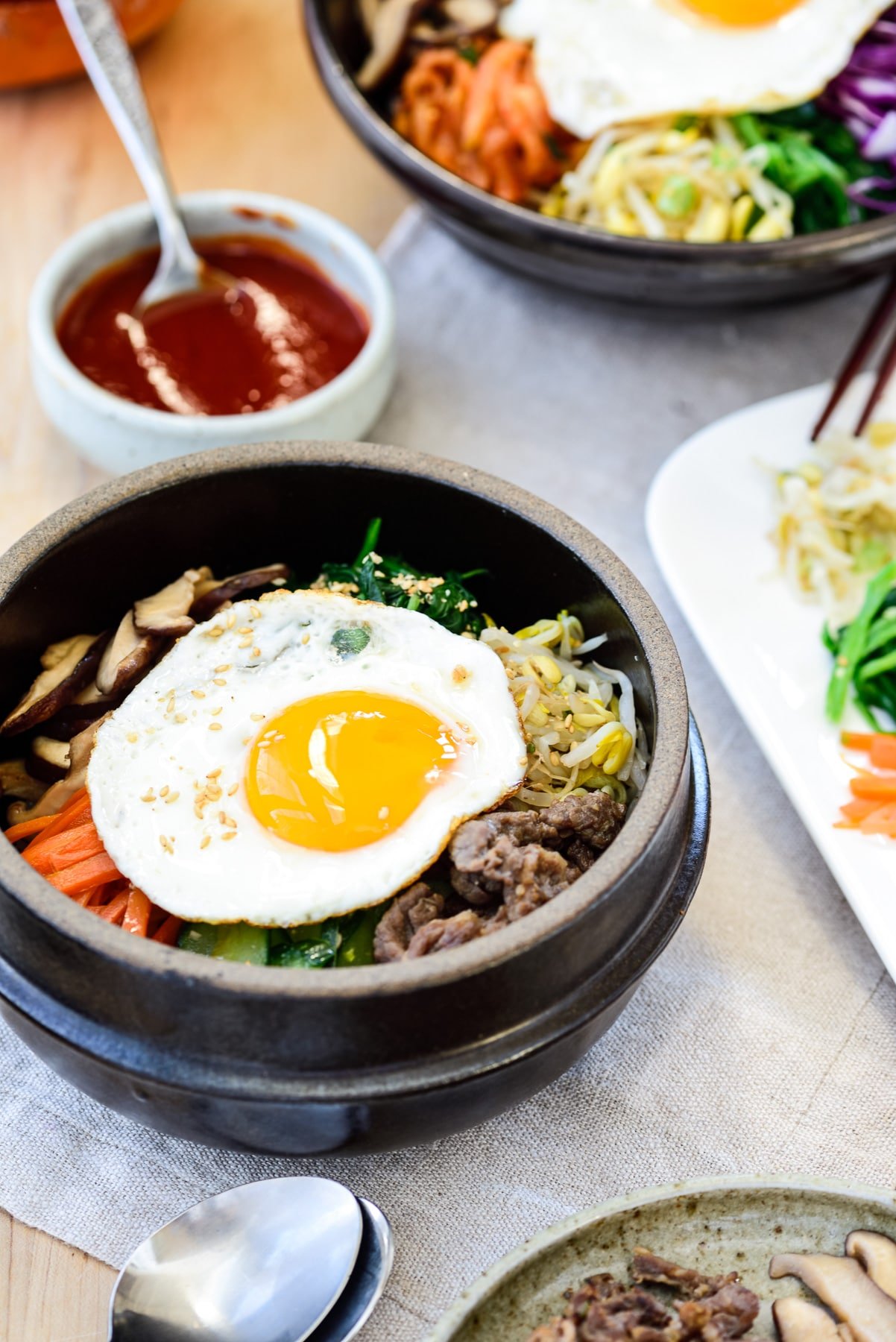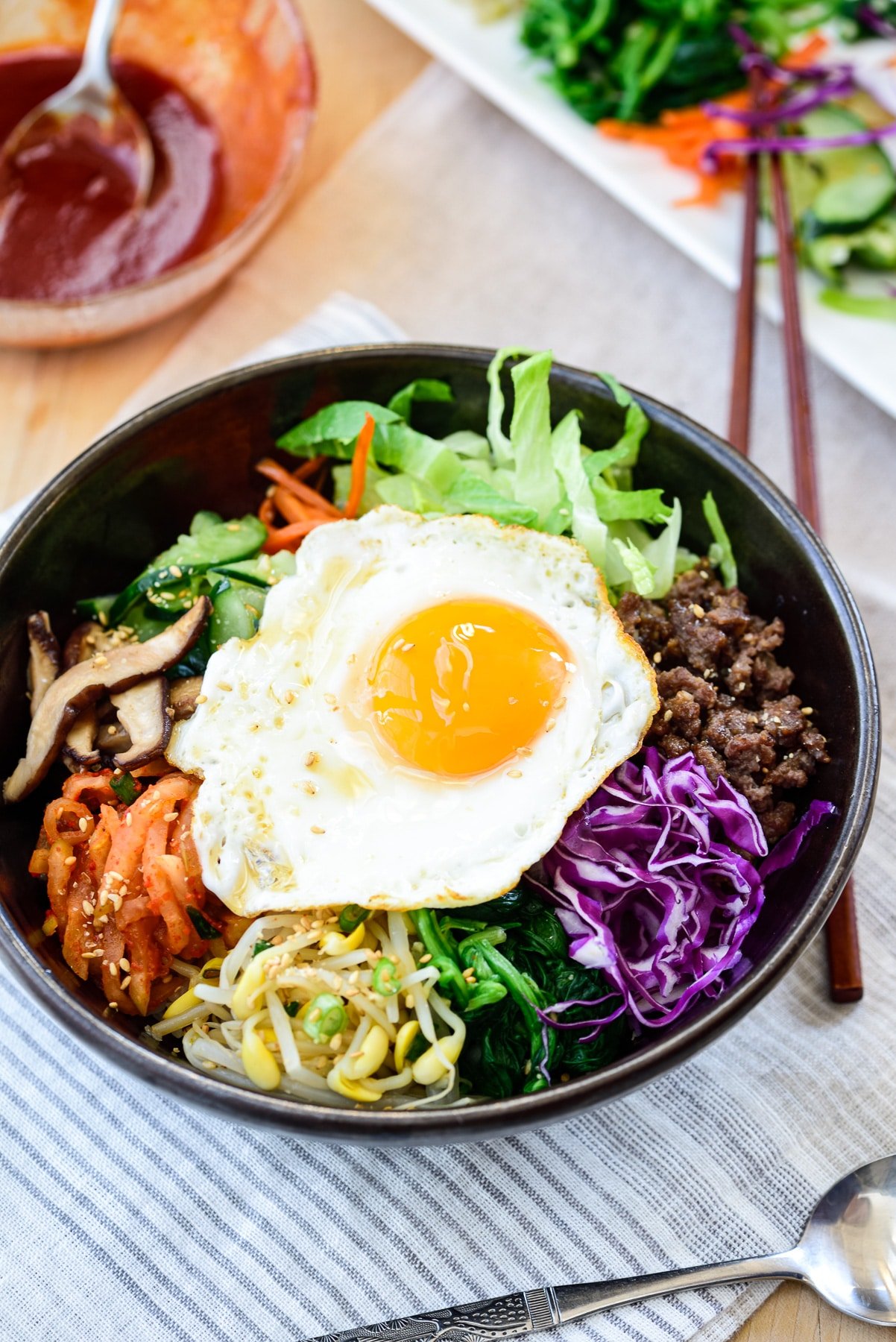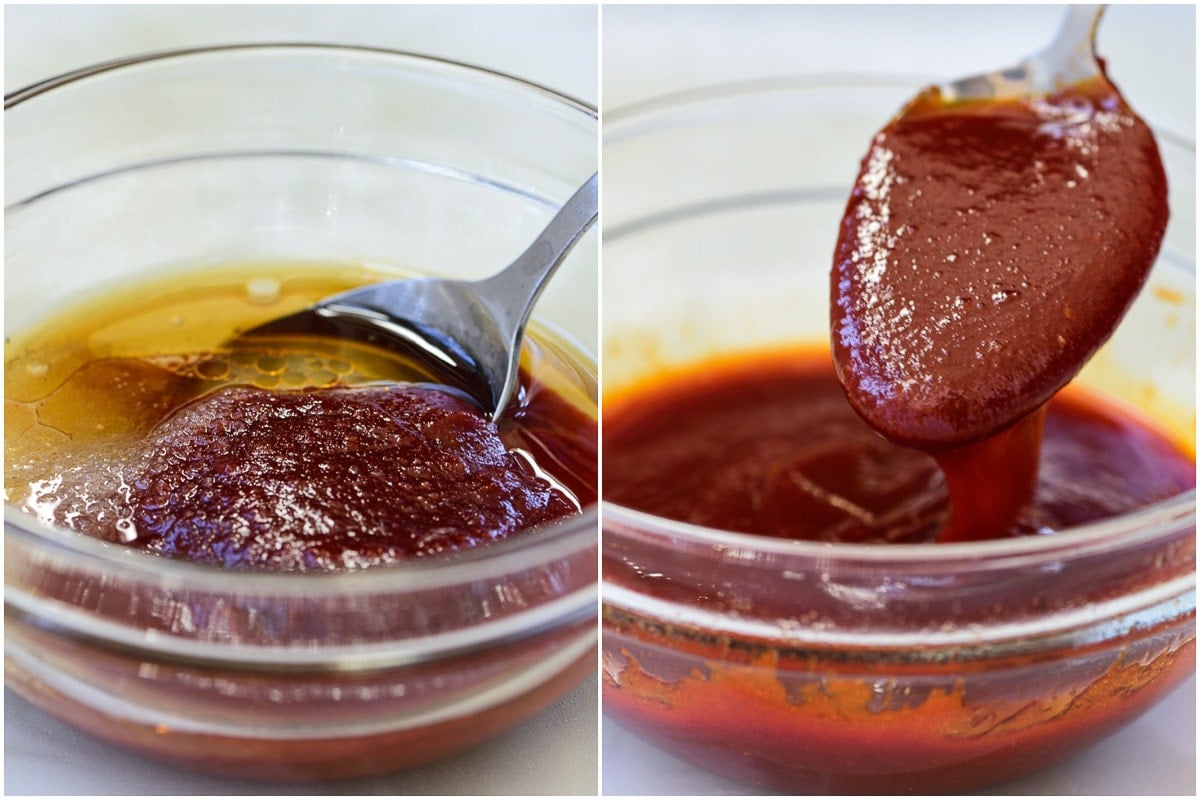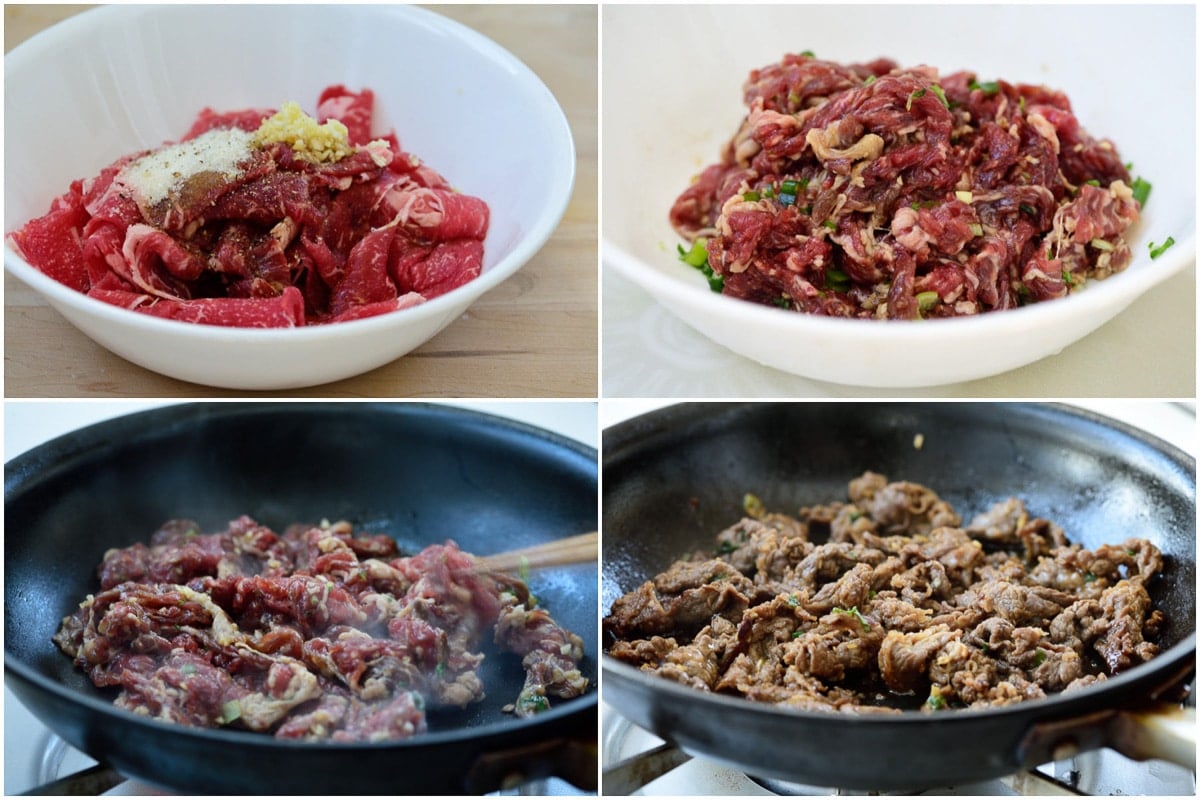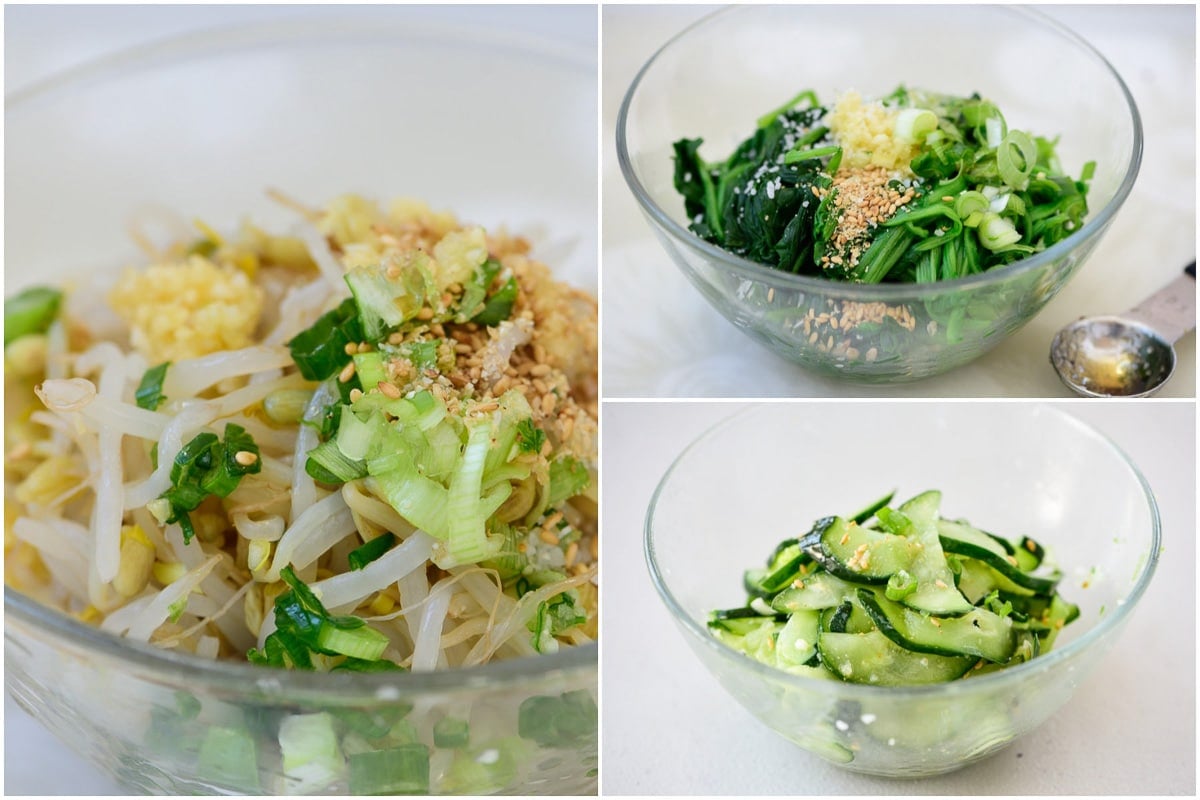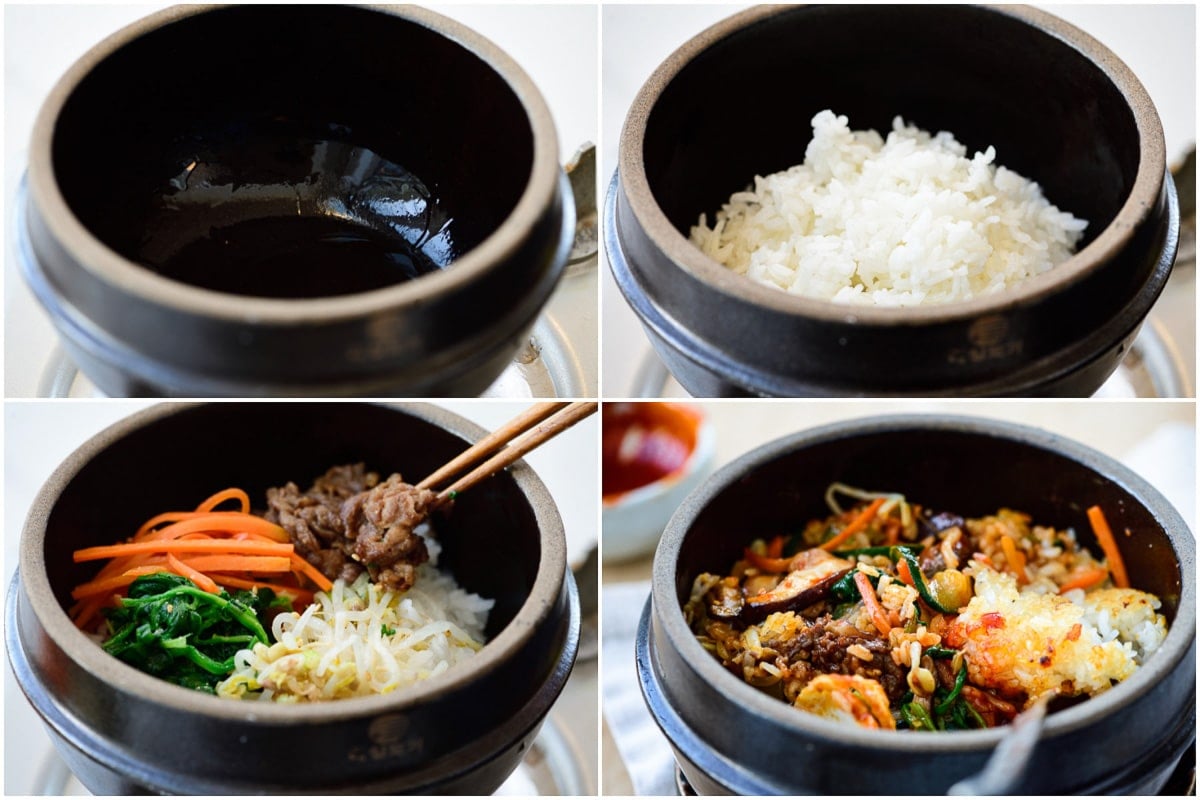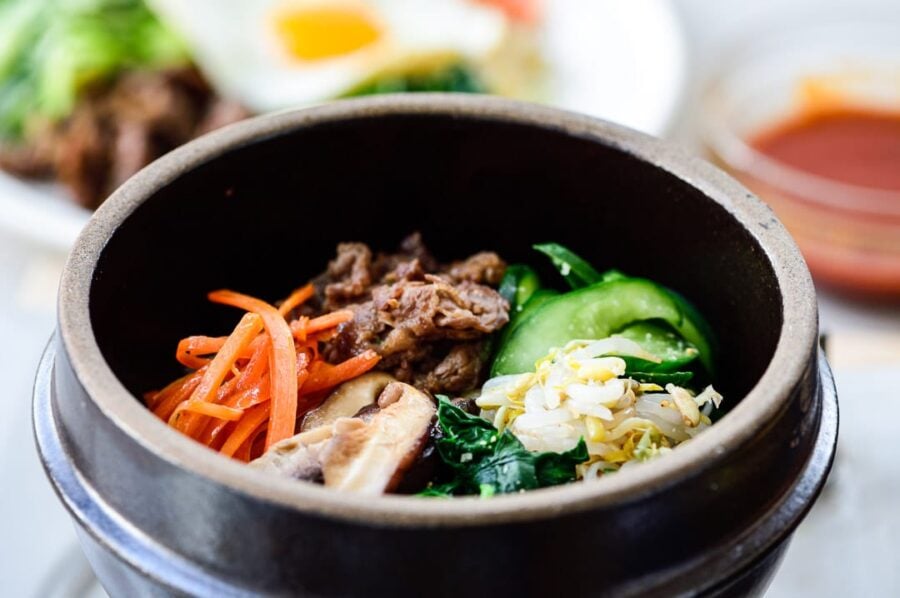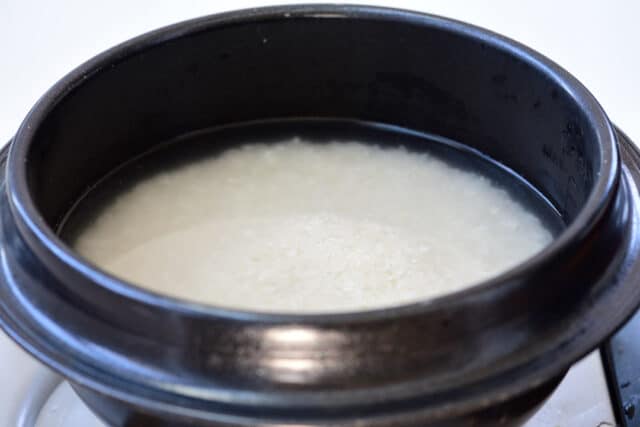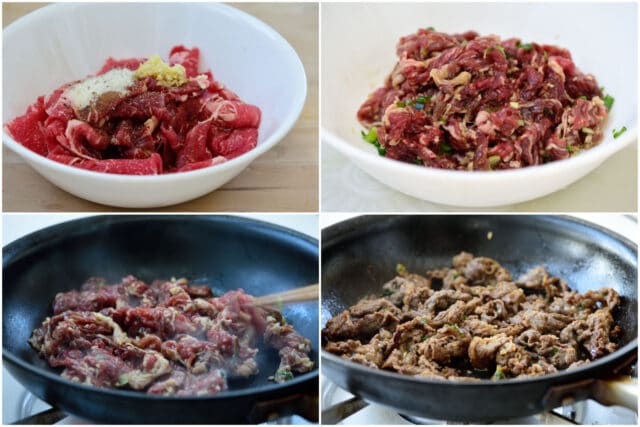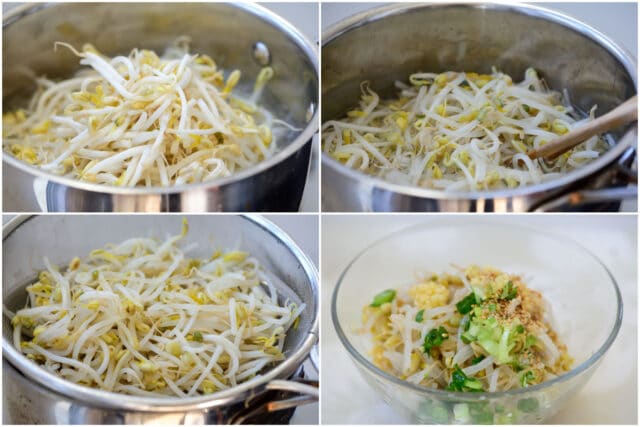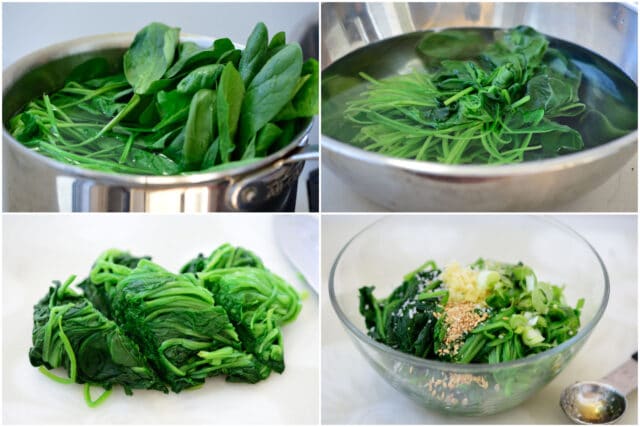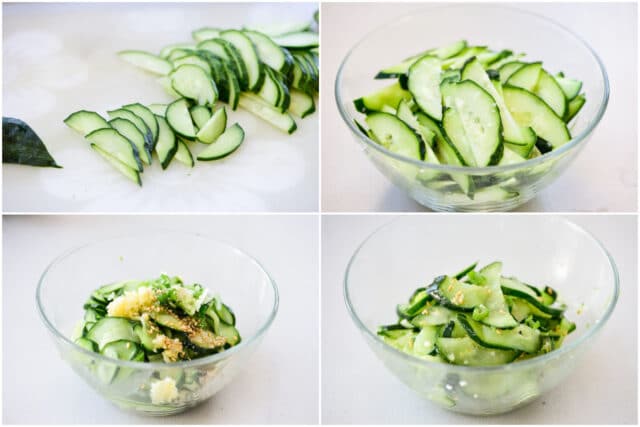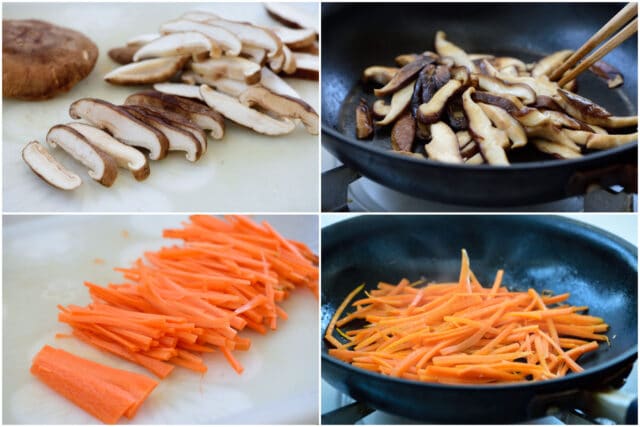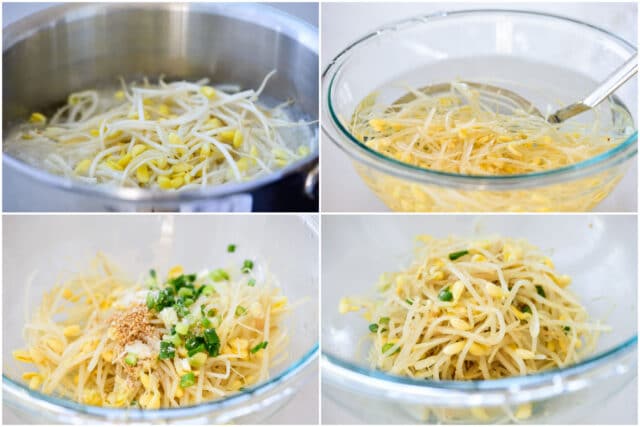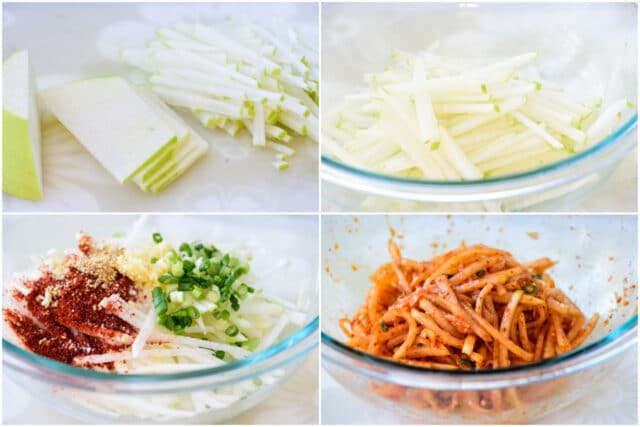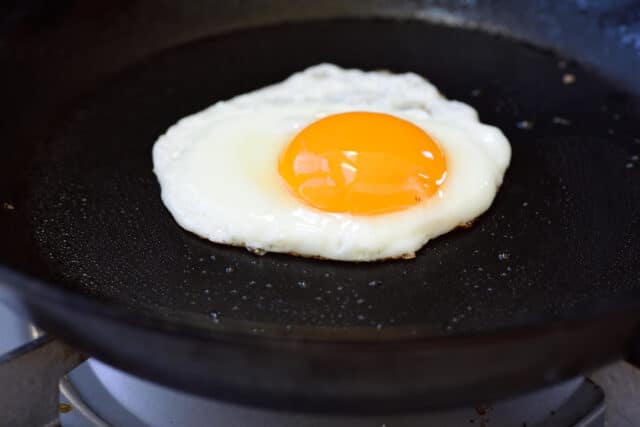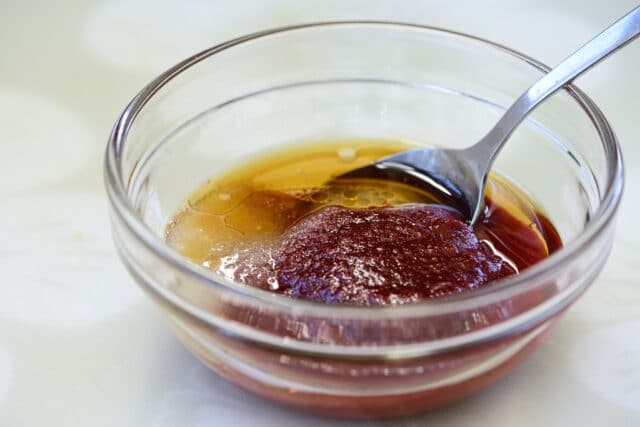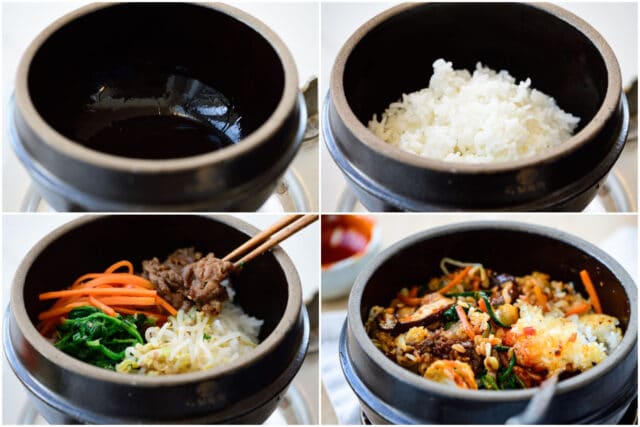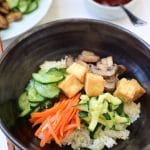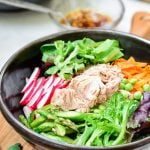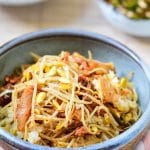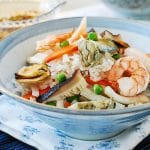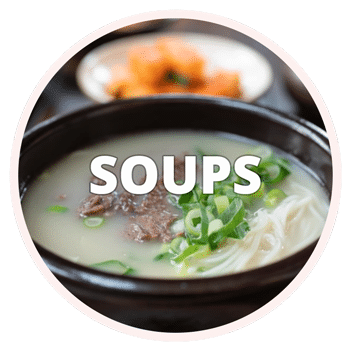A wholesome rice bowl of classic bibimbap vegetables, beef and a gochujang sauce! Enjoy it at home with this easy bibimbap recipe. You can omit the meat and egg for vegetarian or vegan bibimbap.
What is bibimbap?
Bibimbap (비빔밥) is a large bowl of rice topped with an array of individually prepared vegetables and meat and served with a gochujang (고추장) sauce. Bibim means mixing, and bap means rice. The mixing usually happens at the table by the diner.
Once you mix the vegetables, meat, and rice with a spicy gochujang sauce, you can enjoy a delicious harmony of different flavors and textures with every bite. This wholesome rice bowl is one of my absolute favorite Korean comfort foods!
In Korea, there are many different types of bibimbap depending on toppings, regions, sauces, etc. Sannamul (산나물, wild vegetables) bibimbap, jeyuk (제육, spicy pork) bibimbap, haemul (해물, seafood) bibimbap, and yeolmu (열무, young radish greens) bibimbap are a few examples.
The most famous bibimbap, however, comes from Jeonju, the capital city of North Jeolla Province. Jeonju bibimbap is known for quality ingredients and elaborate preparations with as many as 30 toppings.
At home, we often make this dish using the side dishes left over from previous meals. It’s a delicious way to use up the leftovers. But, you can easily make it with a few freshly made simple side dishes. Hope you enjoy it at home with this easy to follow bibimbap recipe.
Once you mix the vegetables, meat, and rice with a spicy gochujang sauce, you can enjoy a delicious harmony of different flavors and textures with every bite. It’s one of my absolute favorite Korean comfort foods! Hope you enjoy it at home with this easy to follow bibimbap recipe.
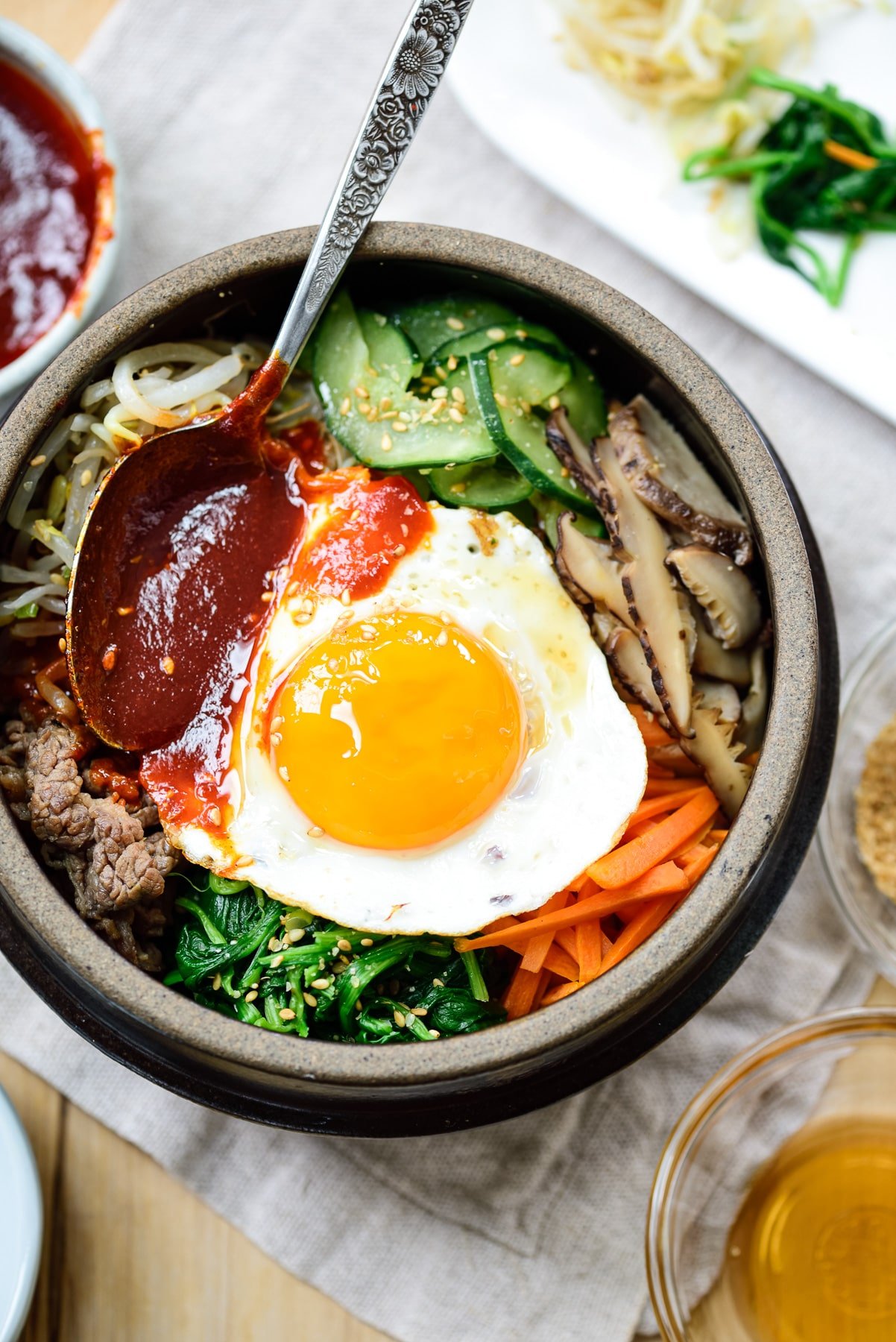
Bibimbap Ingredients
As mentioned above, there are many variations of bibimbap. The most common type of bibimbap includes beef and a few vegetables and is usually topped with a sunny side up fried egg.
For the meat, bulgogi style beef is most common, but you can also use ground beef seasoned the same way. You can also use chicken bulgogi or spicy pork if you like.
While bibimbap vegetable options are endless and you can use any number of them, here are common bibimbap vegetables that I used in this recipe:
- Beansprouts (sukju namul, 숙주나물) or soybean sprouts (kongnamul, 콩나물 ). In Korea, kongnamul is more common in bibimbap.
- Spinach (시금치)
- Cucumbers (오이)
- Mushrooms (버섯): Pyogo beoseot (표고버섯) is classic, but you can use any mushrooms you like.
- Carrots (당근): You can use red or orange bell peppers instead.
Other common bibimbap vegetables include zucchini, mu saengchae (radish salad), onion (sliced and sautéd), bellflower roots (doraji – soaked and sautéd), gosari (fiddlehead ferns), lettuce leaves, red cabbage, kimchi, gim (roasted seaweed sheet, aka nori) and so on. Also see my collection of 15 Korean vegetable side dishes for more options.
Which rice to use
Koreans typically use short grain white rice for this dish. If you want to make this Korean rice bowl even healthier, use short grain brown rice or mixed grain rice instead. If short grain rice is not available in your area, use any rice you can find.
Cook the rice in a rice cooker or following package directions, using a little less water than called for. The rice should be a little drier than usual for best results.
Bibimbap sauce
The most common bibimbap sauce is gochujang, but other sauces, such as yangnyeom ganjang (soy sauce based) and doenjang are also used. If you have a tub of ssamjang, it’s great as a bibimbap sauce as well.
The salty, spicy, and slightly sweet and umami packed gochujang doesn’t really need much of anything else for bibimbap. I simply use some water to thin it out for easy mixing and add a little bit of sugar and sesame oil. That’s it! The thickness and sweetness of gochujang vary, depending on the brand. Also, if your gochujang has been sitting in your fridge, it probably has dried out a bit too. Adjust the amounts of water and sugar accordingly.
How to make it
This recipe seems long, but it’s actually a collection of several basic side dishes (banchan) that are very simple to make. Season individual toppings lightly as everything will be mixed with a gochujang sauce.
Beef: Unless you’re using pre-cut bulgogi meat or ground beef, cut the beef into thin, bite sized strips/slices. Mix in the marinade ingredients and marinate for about 20 minutes. Sauté in a skillet for 2 – 3 minutes over high heat.
Vegetables: The vegetable toppings are basically namul dishes (seasoned vegetable side dishes). They are either blanched, salted or stir-fried before being seasoned with a few basic seasoning ingredients.
For the beansprouts and spinach, bring some water to a boil and blanch the vegetable. Drain quickly and shock in cold water to stop cooking. Drain again. Toss with the seasoning ingredients. If using soybean sprouts (kongnamul) instead, I’ve added it in the recipe card under More Vegetable Options.
Cut the cucumbers in half lengthwise and then thinly slice crosswise. Generously sprinkle salt over sliced cucumbers and set aside for 10 – 15 minutes. Squeeze out excess liquid. Toss with the seasoning ingredients.
For the mushrooms and carrots, thinly slice them. Sauté each vegetable in a lightly oiled skillet for 1 – 2 minutes over medium-high heat, sprinkling salt and pepper to taste. You can cook zucchini or onion slices the same way, if using.
An egg can be sunny side up, or fully cooked. Sometimes, only a raw egg yoke is used, which is typical for Jeonju bibimbap.
Dolsot bibimbap
You can simply serve bibimbap in a large bowl at room temperature. However, when it’s served in a sizzling hot stone bowl (dolsot), your dining experience will rise to the next level. The hot stone bowl gives the bottom layer of rice a nice golden crust, and the rest of the bowl sizzles while being mixed.
Lightly oil a stone or earthenware bowl with a teaspoon of sesame oil over medium heat. Add a serving of cooked rice and arrange the toppings on top. Cook for several minutes until the rice sizzles.
There are various types of stone pots or earthenwares available at Korean markets and/or on line. If unavailable, use a cast iron pan or a casserole dish for the similar effect.
Vegetarian or vegan bibimbap
Making a vegetarian or vegan bibimbap is easy! Simply skip the meat and egg. A few vegetable toppings will be great, but tofu is a great meat substitute and a protein option. As I showed in my tofu bibimbap recipe, pan-frying the tofu enhances the nutty flavor of the tofu and gives it a nice chewy texture.
If you have vegetarian/vegan kimchi, slice it up a little. It will make a nice addition to your rice bowl.
More bibimbap recipes
Tofu Bibimbap – vegan
Spring Bibimbap with Canned Tuna
For more Korean cooking inspirations, follow along on YouTube, Pinterest, Twitter, Facebook, and Instagram.
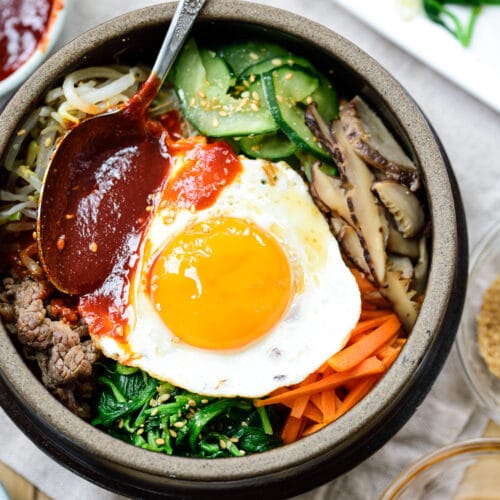
Ingredients
Rice:
- 3 cups short grain rice
Meat:
- 8 ounces thinly sliced tender beef (rib eye, sirloin, etc. or ground beef)
- 1.5 tablespoons soy sauce
- 2 teaspoons sugar
- 2 teaspoons sesame oil
- 2 teaspoons rice wine
- 1 teaspoon minced garlic (This recipes needs 2.5 teaspoons minced garlic in total. Mince it all at once for efficiency.)
- 1 tablespoon chopped scallion (This recipe needs 4 tablespoons, 1 or 2 scallions depending on the size, in total. Chop them all once for efficiency.)
- pepper to taste
Vegetables and eggs:
- 8 ounces mung bean sprouts (sukju, 숙주) or soybean sprouts (kongnamul, 콩나물) - see more vegetable options below.
- 1 bunch spinach, about 8 ounces
- 2 small cucumbers, about 5 ounces
- 4 ounces mushrooms (shiitake, white, cremini, etc.)
- 2 medium carrots, about 5 ounces
- 1.5 teaspoons minced garlic, divided
- 3 3 tablespoons chopped scallion, divided
- sesame oil
- sesame seeds
- salt
- 4 eggs - optional
- cooking oil
More vegetable options
- 8 ounces Kongnamul (soybean sprouts)
- 10 ounces mu (Korean radish)
Bibimbap sauce
- 4 tablespoons gochujang, 고추장
- 2 teaspoons sugar - adjust to taste, 1-3 teaspoons
- 1 tablespoon sesame oil
- 1 tablespoon water
Instructions
Rice:
- Cook the rice, without soaking and using a little less water than the amount you normally use. The rice for bibimbap should be a little drier than usual for best results.
Meat:
- Beef: Cut into thin 2-inch long strips. Mix in 1.5 tablespoons of soy sauce, 2 teaspoons of sugar, 2 teaspoons of sesame oil, 2 teaspoons of rice wine, 1 tablespoon of chopped scallion, 1 teaspoon minced garlic, 1/2 sesame seeds and a pinch of pepper. Marinate for 20 minutes. Sauté in a skillet for 2-3 minutes over high heat.
Vegetables:
- Bean sprouts: Bring 2 cups of water to a boil. Add the bean sprouts and briefly blanch, about 1 minute, flipping over once. Drain quickly and shock in cold water to stop cooking. Drain again. Toss with 1/2 teaspoon of minced garlic, 1 teaspoon of sesame oil, 1/2 teaspoon of sesame seeds, and salt (about 1/2 teaspoon).
- Spinach: Blanch the spinach in salted boiling water only until wilted, about 40 seconds. Drain quickly and shock in cold water. Squeeze out water. Cut into 3-inch lengths. Toss with 1 tablespoon of chopped scallion, 1/2 teaspoon minced garlic, 1 teaspoon of sesame oil, 1/2 teaspoon of sesame seeds and salt (about 1/2 teaspoon).
- Cucumbers: Cut the cucumbers in half lengthwise and then thinly slice crosswise. Generously sprinkle salt (about 1/2 teaspoon) over sliced cucumbers and set aside for 10 - 15 minutes. Squeeze out excess liquid. Toss with 1 tablespoon of chopped scallion, 1/2 teaspoon minced garlic, 1 teaspoon sesame oil and 1/2 teaspoon of sesame seeds.
- Mushrooms and carrots: Thinly slice the mushrooms and carrots. Sauté each vegetable in a lightly oiled skillet for 1 - 2 minutes over medium-high heat, sprinkling with salt (about 1/4 teaspoon).
More vegetable options:
- Kongnamul (Soybean sprouts): Bring 2 cups of water to a boil. Add the soy beansprouts and boil for 2-3 minutes. Drain quickly and shock in cold water to stop cooking. Drain again. Toss with 1/2 teaspoon of minced garlic, 1 teaspoon of sesame oil, 1/2 teaspoon of sesame seeds, and salt (about 1/2 teaspoon) to taste.
- Musaengchae (spicy radish salad): Cut 10 ounces of Korean radish (mu) into matchsticks. Add 2 tablespoons of chopped scallion, 1 tablespoon of gochugaru, 1 teaspoon minced garlic, 1/2 teaspoon salt (or more to taste), 1 teaspoon sugar, and 1 teaspoon sesame seeds. Mix everything well.
Optional Eggs:
- Fry the eggs sunny side up or to your preference.
Bibimbap sauce:
- Combine all of the sauce ingredients in a small bowl and mix thoroughly.
Assembling:
- Place a serving of rice in a big bowl. Nicely arrange a small amount of each prepared vegetable and beef over the rice. Drizzle a little sesame oil over. Top with an optional fried egg and serve with the sauce.
- For dolsot bibimbap: Lightly oil a stone or earthenware bowl with a teaspoon of sesame oil over medium heat. Add a serving of cooked rice and arrange the toppings on top. Cook for several minutes until the rice sizzles.
Notes
This easy bibimbap recipe was originally posted on this blog back in February 2010. I’ve updated it with the new photos, more information and different variations and topping options.


